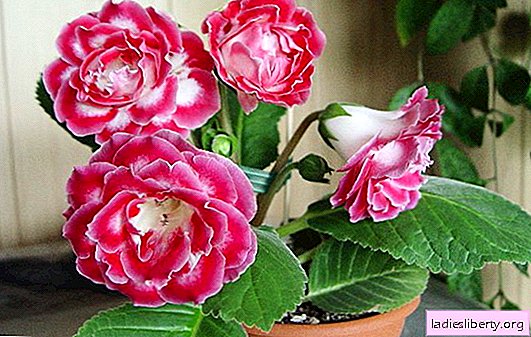
Strawberry is a light-loving and heat-loving berry, which requires careful care and special growing conditions. In one place, it can give a high yield for 3 to 4 years, after which it is better to transplant the bushes to another site.
It should be borne in mind that for planting this crop, you need to choose sunny and sufficiently ventilated areas.
The successful cultivation of strawberries and their productivity will depend on the planting, proper care, as well as the choice of a good planting material.
Selection of planting material
In the role of planting material are young bushes growing on the mustache of large uterine bushes. Usually they appear every year, but not all are suitable for planting. You need to take outlets that are as close as possible to the mother plant. It is advisable to harvest seedlings from those bushes that give a high yield. They must be between 2 and 3 years old. If the uterine bushes are older, the yield will not be high. In addition, such planting material will develop better.

The mustache begins to form after the flowering of strawberries, but only after harvesting they develop well and rosettes with leaves appear on them. After some time, small bushes take root on them. They can be taken for landing. It is not necessary to use bushes obtained as a result of dividing a large bush as planting material. In this case, all of his diseases will go to the daughter outlet.
When choosing planting material, it is first necessary to pay attention to its roots. They must be well developed. In this case, even a weak leaf rosette will take root well and quickly and will develop correctly, giving a large harvest in the future. If the bushes for planting will have weak roots, they may simply die after planting.
Preparing a place for planting strawberries
Wanting to get a good harvest, you should seriously consider the choice of the place where strawberries will be planted. First of all, it should be a flat surface. Southwest slopes are well suited. Do not plant bushes on steep slopes. Snow will quickly fall there, which will expose the roots. In such places, plants will often hurt, and berries will appear later than the due date. A place in the lowlands where water constantly stands is also not suitable, which is also detrimental to the roots.
After choosing a suitable place, you can proceed to the preparation of the soil. It is necessary to create all the necessary conditions.so that planted plants take root. To do this, dig the soil, fertilize it well, and also clear it of weeds and pests. We must try to dig the soil as deep as possible, because this will help create good conditions for the development of the root system. It will be more sustainable, resulting in higher yields. If you plan to plant strawberries in the spring, then digging the land must be carried out in the fall. For autumn planting, the soil is prepared 2 to 3 weeks before planting.
Under digging, you need to make organic fertilizers. Their role may be rotted manure, compost, peat, etc. Mineral fertilizer is also used. For 1 square meter, you can make 2 tbsp. tablespoons nitrofoski. Do not abuse fertilizers too much, otherwise growth processes will intensify in strawberries, which will be detrimental to fruiting. If the soil itself is quite fertile, then there is no need to fertilize it additionally.
After digging and fertilizing the soil, you need to form beds. If groundwater passes nearby and the terrain is quite low, then you need to make them higher. It will be enough to make beds 30 - 35 cm high. If the terrain is dry, then they can be raised by 10 cm or simply not raised. You can sprinkle some coarse sand on top. Due to this, there will be fewer pests in the soil, such as slugs, centipedes, and snails.
Planting strawberries
You can plant strawberries in August. The best deadlines are from July 25 to August 10. At this time, you can grow well-developed plants that have powerful roots. However, everything will depend on the region and climate. In some southern regions, where there is intense heat in August, landing is carried out in early September. You can plant strawberries in the spring. This should be done as soon as the seedlings grow.
If you use your own seedlings for planting, then it must be separated from the uterine bush with a small lump of earth, and then immediately planted on the bed. In the event that the seedlings were purchased elsewhere, then they must be placed in saline for 10-15 minutes with the addition of copper sulfate. To prepare it, you need to dilute 3 tbsp. tablespoons of salt in 10 liters of water and add to them 1 small spoonful of copper sulfate. To place in this solution you need to completely sockets with the root system. After that, they should be removed and rinsed in clean water. Now the bushes can be planted on the bed.
There are several ways to plant strawberries:
1. Seedlings of early varieties are planted close to each other. A thickened landing is made. For this, each plant is placed at a distance of 15 cm from each other. A distance of 60 cm should remain between the rows. With this arrangement of rows in the first year, high productivity will be achieved. However, after collecting the last berries, you need to remove every second plant. At the same time, the distance between the bushes will increase to 30 cm. This will achieve a good harvest in the second year.
2. Late seedlings need to be planted at a distance of about 20 cm from each other. There should also be 60 cm between rows. After the crop is harvested, every second bush must be removed so that the distance increases to 40 cm.
3. You can grow strawberries on vertical and multi-tiered beds. For this, containers and other containers are used, which are located vertically. You can independently make shapes in the form of a pyramid or cone. This saves space and is suitable for those who have a small plot. The main thing is that the capacity volume is more than one and a half liters, which is necessary for the root system. It is filled with pre-prepared soil.

Regardless of which method is chosen, strawberries need to be planted in the evening or cloudy weather. Plants should be acclimatized. In rows, you need to make small holes and pour a liter of water into each of them. After that, seedlings can be planted in the wells. Be sure to make sure that the heart located above the roots is not too deeply deepened or raised. This will cause the bush to rot or dry out. The roots should be straightened so that they are not bent. Each bush is covered with earth. If the soil is not too wet, then it can be watered even from above.

After the strawberries are planted, the aisles need to be loosened. With proper planting, good sprawling bushes will be formed by winter, which in the summer will give the first crop.
Strawberry care: watering, mulching, frost protection
Strawberries require special care, in which the main role is played by watering. You can determine its frequency by analyzing the soil moisture at a depth of twenty meters. If it is dry, then water is simply necessary for plants, but if the soil is even a little wet, then there is enough water. Do not overmoisten the soil too much, because how it will adversely affect strawberries. On average, during the growth of bushes, you need to water them once every 7 to 10 days. After the berries begin to appear, they need to be watered more often, reducing the interval to 5 days. It is also important how to water strawberries. This should be done from a watering can only at the root or with the help of drip irrigation.
From time to time after watering it is necessary to carry out loosening soil between rows and directly around the bushes. You need to do this 7-8 times during the summer, but everything will depend on the state of the soil. This should be done when the crust appears. Weeding the beds is also necessary when weeds appear. Such care is simply necessary, because the condition of the bushes will depend on this.
In order for moisture to remain in the soil mulching. The role of mulch can be rotted straw, tree leaves, reeds, etc. All this must be spread in the aisles after the first spring cultivation. It is allowed to spread the mulch with a layer of 7 - 8 cm. This will not only help retain moisture in the soil, but also protect the berries from contamination.
Strawberry care comes down to mustache removal. They appear around each bush. It is necessary to leave only those mustaches that are required for seedlings. The rest will only prevent the bushes from growing properly and gaining strength. If the mustache is removed, the crop will be higher and the berries large. If some bushes died after the winter, then in their place you need to plant new ones.
In winter time strawberries can be damaged by frost. To prevent this, cover it with leaves or straw. It is necessary to lay it not only on the leaves, but also in the aisles. This will protect the root system from frost. In hot areas, strawberry cultivation is complicated by the fact that the leaves quickly wither and dry out from the heat. To avoid this, between the rows you can plant onions, garlic, etc.
Strawberry dressing
If the soil was fertilized before planting, then additional fertilizing may not be required for the first two years. However, the need for fertilizer will depend on the fertility and general condition of the plants. You need to make them in the second or third year. It is advisable to do this in the fall or early spring. Both organic and mineral fertilizers are suitable. You can use bird droppings, humus, ash, compost, etc.
Fertilizers must be evenly distributed between the rows, as well as near each bush. After that, they should be repaired in the soil using a shovel or hoe. Thus, fertilizers can be applied annually if the soil is depleted. If this was not done in autumn or early spring, then top dressing can be applied before flowering plants. You can use slurry or bird droppings for this. Another such top dressing should be done before the berries ripen. It is only necessary to apply such fertilizer in liquid form to previously prepared grooves in the aisles.
To prepare slurry, it must be diluted with a triple amount of water so as not to burn the plants. If you use mineral fertilizers, then you need to breed them in a proportion of 5 - 6 buckets of water per 1 kg. After fertilizing, strawberries need to be watered and the grooves in the aisles to be buried. After a while, the soil needs to be loosened. Do not feed in dry weather.
Diseases and pests. Measures to combat them
Strawberries can be susceptible to various diseases. The most dangerous and common ones include:
1. Gray rot. Softened brown spots begin to appear on the berries. They gradually increase and the berries are covered with a thick gray coating, resulting in rot. To fight this disease, strawberries need to be treated with Barrier and HOM.

2. Powdery mildew. Here the leaves are first affected. They twist and become rough, acquiring a light bronze hue. The berries begin to become powdery and rot. To fight, you need to spray the beds with a solution of manganese potassium or colloidal sulfur before the buds appear. Affected berries need to be burned. Another treatment needs to be done after harvesting. You can use the drug "Topaz".

3. Strawberry spotting is white, brown and brown.. It manifests itself as spots on the leaves, which subsequently fall off. To prevent the need to spray the leaves with the drug "Barrier".

In addition to diseases, strawberries can interfere with the safe growth of strawberries. pests such as:
1. Transparent tickdamaging young leaves. At the same time, they curl and turn yellow. Berries become small. Ticks multiply in wet weather. To combat them, you need to spray strawberries with Karate after harvest.
2. Slugs, millipedes, snails, ants - damage the berries. They are especially common in damp and shady places. To combat them before flowering, as well as after harvesting, strawberries need to be sprayed with Arrow.
If you carry out all the necessary measures for the care and protection of strawberries on time, you can get a large collection of berries. If you do not deal with pests, then all labor will be in vain.











